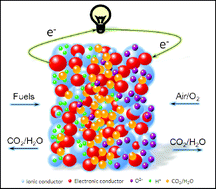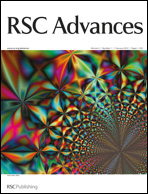Advanced electrolyte-free fuel cells based on functional nanocomposites of a single porous component: analysis, modeling and validation
Abstract
Recently, a fuel cell device constructed with only one layer composited of ceria-based nanocomposites (typically, lithium nickel oxide and gadolinium doped ceria (LiNiO2–GDC) composite materials), called an electrolyte-free fuel cell (EFFC), was realized for energy conversion by Zhu et al. The maxium power density of this single-component fuel cell is 450 mW cm−2 at 550 °C when using hydrogen fuel. In this study, a model was developed to evaluate the performance of an EFFC. The kinetics of anodic and cathodic reactions were modeled based on electrochemical impedance spectroscopy (EIS) measurements. The results show that both of the anodic and cathodic reactions are kinetically fast processes at 500 °C. Safety issues of an EFFC using oxidant and fuels at the same time without a gas-tight separator were analyzed under open circuit and normal operation states, respectively. The reaction depth of anodic and cathodic processes dominated the competition between surface electrochemical and gas-phase reactions which were effected by the catalytic activity and porosity of the materials. The voltage and power output of an EFFC were calculated based on the model and compared with the experimental results.


 Please wait while we load your content...
Please wait while we load your content...